Welcome to the lush world of Elephant Ear Begonia, a captivating plant that adds a touch of tropical elegance to any space. Named for its distinctive large, ear-shaped leaves, this begonia variety boasts an exotic charm that plant enthusiasts find irresistible.
Elephant Ear Begonia (Begonia Scharffiana) is a species of begonia native to the Hengduan Mountains in Southwest China. With its bold foliage, this plant stands out in both indoor and outdoor settings, making it a popular choice for gardens and homes alike.
Key Features:
- Leaves: The most striking feature of the Elephant Ear Begonia is its large, asymmetrical leaves that resemble the ears of an elephant. The leaves are glossy, dark green, and can grow up to 8 inches in length.
- Stems: Sturdy, succulent stems support the impressive foliage, adding to the plant’s overall robust appearance.
- Blooms: While Elephant Ear Begonias are not primarily grown for their flowers, they do produce small, inconspicuous blooms on occasion. The focus, however, remains on the captivating leaves.
This plant’s unique appearance makes it a focal point in any botanical collection, and its relative ease of care makes it an excellent choice for both beginners and experienced gardeners.
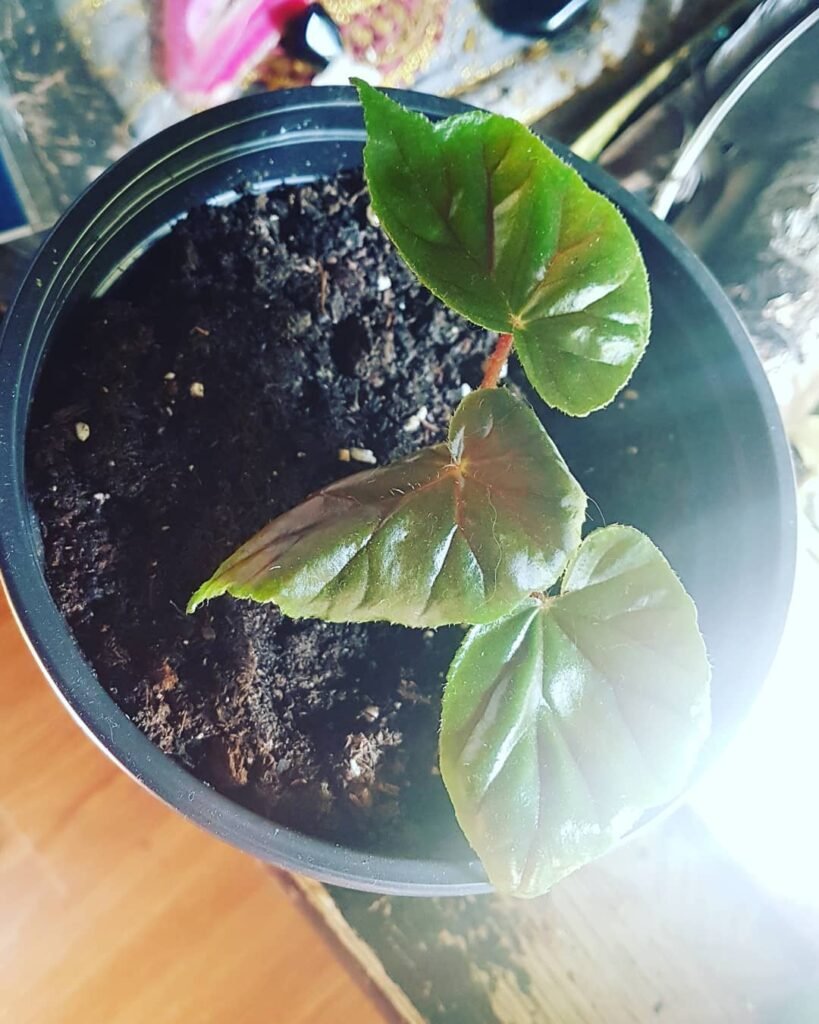
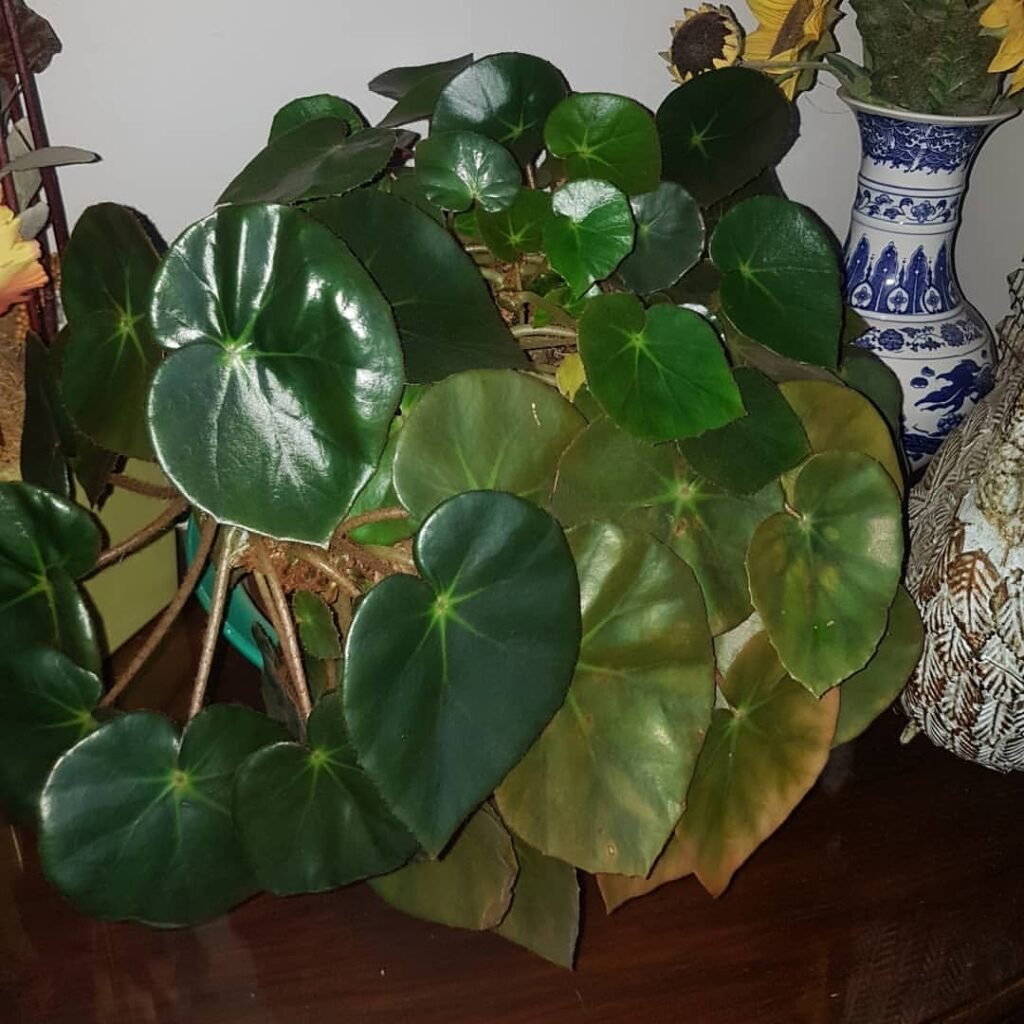

Elephant Ear Begonia Care Guide Overview
Embarking on a journey to cultivate and nurture your Elephant Ear Begonia? Let’s dive into an overview of its care requirements to ensure your plant thrives and flourishes.
Care Essentials:
| Care Aspect | Details |
|---|---|
| Light Requirements | Bright, indirect light is ideal. Avoid direct sunlight, which can scorch the leaves. |
| Soil Type | Well-draining soil with organic matter. |
| Watering Frequency | Allow the top inch of soil to dry between watering. Overwatering can lead to root rot. |
| Humidity Preferences | Moderate to high humidity levels are preferred. Mist the plant or use a humidifier, especially in dry climates. |
| Temperature Range | Keep the temperature between 65°F to 75°F (18°C to 24°C). Avoid drafts and sudden temperature changes. |
| Fertilizing Schedule | Feed with a balanced liquid fertilizer every 4-6 weeks during the growing season (spring and summer). |
| Pruning Needs | Prune to control size and shape. Remove yellow or damaged leaves regularly. |
| Propagation Method | Propagate through stem cuttings. Repot every 1-2 years to refresh the soil. |
| Seasonal Considerations | Adjust care routines based on seasons. Reduce watering in winter and protect from cold drafts. |
| Companion Plants | Pair with plants that have similar care needs, such as ferns or pothos. |
| Pest Control Tips | Monitor for pests like spider mites or aphids. Treat with neem oil or insecticidal soap if necessary. |
This overview sets the stage for a thriving Elephant Ear Begonia. In the sections that follow, we’ll delve deeper into each care aspect, providing valuable insights to keep your begonia vibrant and healthy.
Genus Species & Appearance


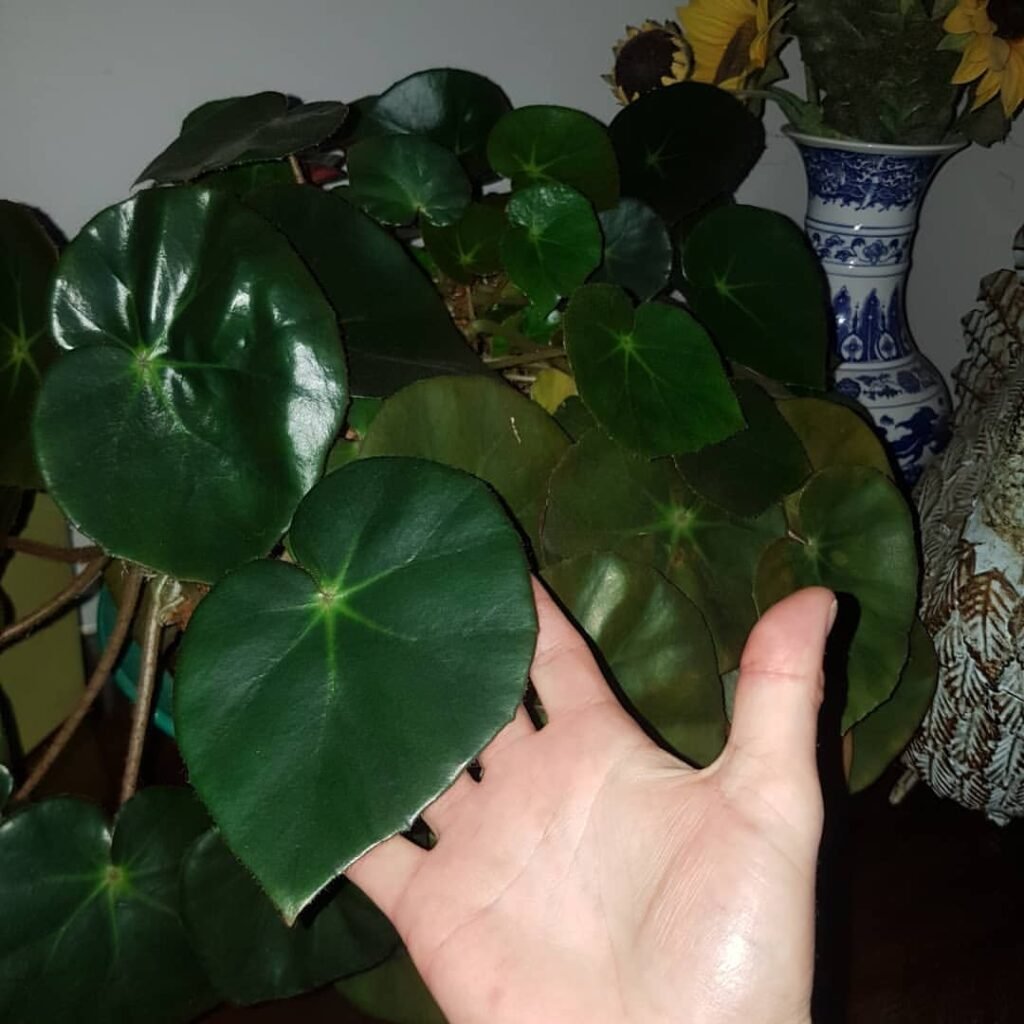
The Elephant Ear Begonia belongs to the Begonia genus, with its scientific name being Begonia Scharffiana. Understanding its genus and species is essential for tailoring care to its specific needs.
Genus and Species:
- Genus: Begonia
- Species: Masoniana
Appearance:
- Leaves: The hallmark of Begonia Scharffiana is its large, asymmetrical leaves. The glossy, dark green foliage showcases unique silver markings, resembling the intricate patterns on an elephant’s ear.
- Stem: The sturdy stems provide structural support to the leaves, contributing to the plant’s overall robustness.
- Size: This begonia can reach a height of around 12 to 18 inches, creating a compact yet impactful presence.
Not the plant for you? Check out my full list of 78 Types of Begonia!
Light and Soil Requirements
Light:
Elephant Ear Begonias thrive in bright, indirect light. Position your plant near a window where it receives filtered sunlight. While they can tolerate some shade, avoid direct sunlight as it can scorch the leaves. If you notice the leaves turning yellow or pale, it might be an indication that the light is too intense.
Soil:
Choosing the right soil is crucial for the well-being of your Elephant Ear Begonia. Opt for a well-draining mix enriched with organic matter. A combination of potting soil and perlite or orchid bark works well. Ensure the pot has drainage holes to prevent waterlogging, which can lead to root rot. Regularly check the soil moisture, allowing the top inch to dry before the next watering.
Care Tip: Consider rotating your plant periodically to ensure all sides receive even light exposure, promoting uniform growth.
Watering

Maintaining the proper watering routine is fundamental to the health of your Elephant Ear Begonia.
Watering Frequency:
Allow the top inch of soil to dry before watering. Stick your finger into the soil – if it feels dry, it’s time to water. Overwatering can lead to root rot, so it’s crucial to strike a balance. Adjust the frequency based on factors like temperature and humidity; during the growing season, you may need to water more frequently.
Hydration Method:
Water your begonia at the base, keeping the leaves dry to prevent fungal issues. Use room-temperature water to avoid shocking the roots. If you’re uncertain about when to water, consider using a moisture meter to gauge the soil’s moisture content accurately.
Care Tip: Place a layer of mulch on the soil surface to help retain moisture and regulate soil temperature. This extra layer can be particularly beneficial in drier climates.
Humidity and Temperature

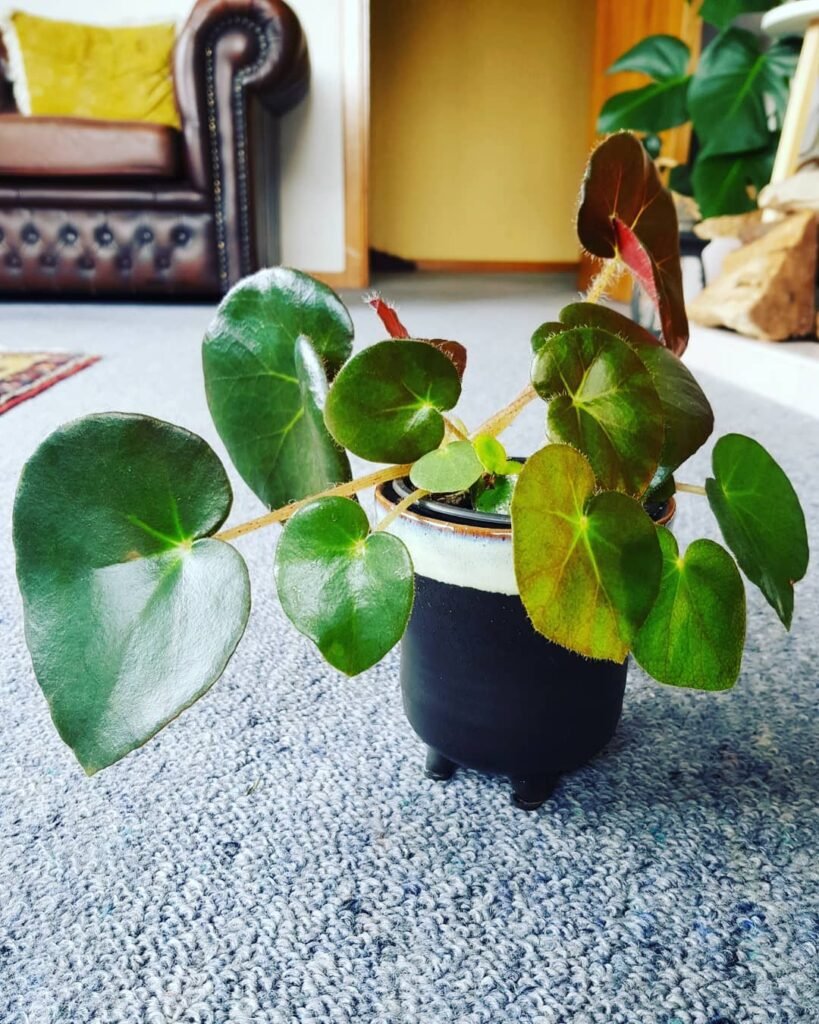

Humidity:
Maintaining the right humidity is key to the well-being of your Elephant Ear Begonia. These plants thrive in moderate to high humidity levels. If you’re in a dry climate or during the winter months when indoor heating can reduce humidity, consider using a humidifier. Alternatively, regularly misting the leaves can create a humid microenvironment around the plant.
Temperature:
Elephant Ear Begonias prefer a consistent temperature between 65°F to 75°F (18°C to 24°C). Avoid exposing the plant to sudden temperature fluctuations or drafts, which can stress the plant. Protect it from cold drafts during the winter months, and if temperatures drop, consider moving your begonia to a warmer location.
| Temperature Range | Ideal Conditions |
|---|---|
| 65°F to 75°F | Optimal growth conditions |
| Below 50°F | Risk of cold damage |
| Above 80°F | Monitor for heat stress |
Maintaining a stable environment, both in terms of humidity and temperature, will contribute to the overall health and vitality of your Elephant Ear Begonia.
Fertilizing

Fertilizing Schedule:
Fertilizing is a crucial aspect of Elephant Ear Begonia care, providing essential nutrients for growth and development. During the growing season, which typically spans from spring to early fall, feed your begonia with a balanced liquid fertilizer every 4-6 weeks. Dilute the fertilizer to half the recommended strength to prevent over-fertilization.
Application Method:
Apply the fertilizer to damp soil to avoid root burn, and always follow the package instructions. Cease fertilization during the dormant period in winter when the plant’s growth slows down. Over-fertilizing can lead to salt build-up in the soil, adversely affecting the health of your begonia.
| Fertilizing Aspect | Details |
|---|---|
| Fertilizer Type | Balanced liquid fertilizer |
| Frequency | Every 4-6 weeks during the growing season |
| Dilution | Half the recommended strength |
| Winter Fertilization | Cease fertilization during the dormant period |
| Signs of Overfeeding | Yellowing leaves, burnt edges, or stunted growth |
Adhering to a well-planned fertilizing schedule ensures that your Elephant Ear Begonia receives the nutrients it needs without the risk of nutrient imbalances.
Pruning and Shaping
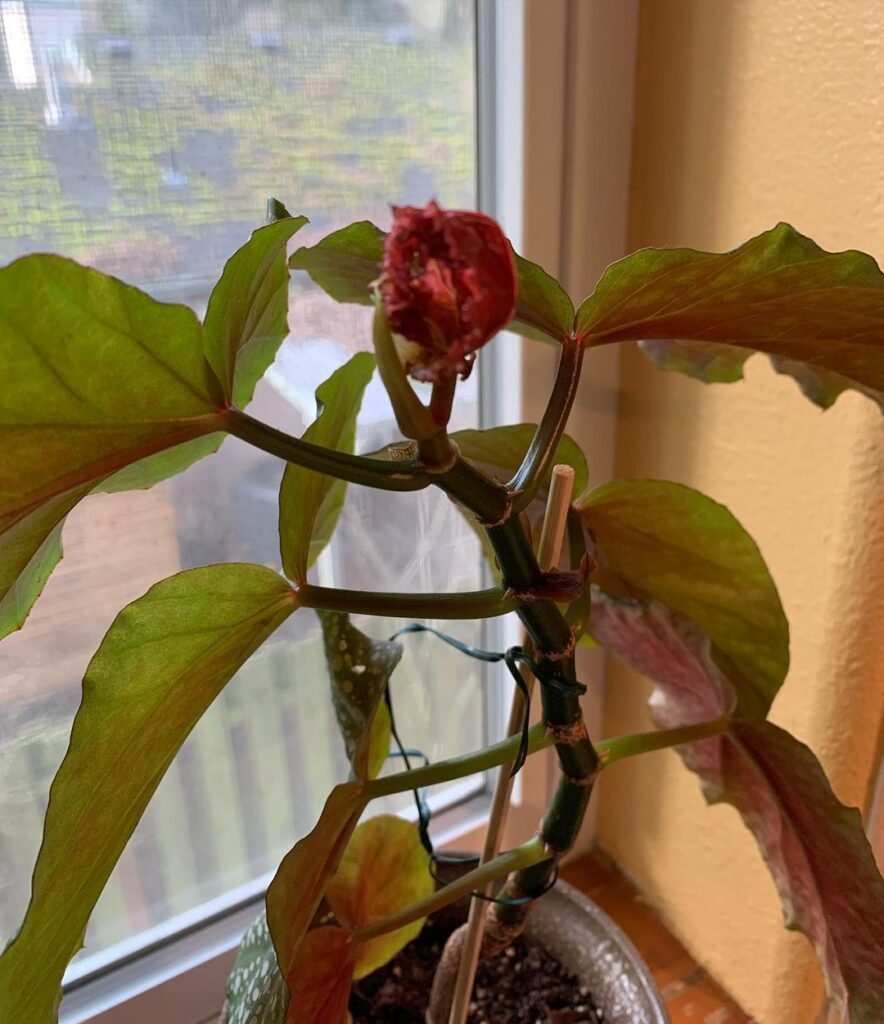


Pruning:
Pruning your Elephant Ear Begonia is an essential practice to maintain its shape and promote healthy growth. Regularly inspect your plant for any dead or yellowing leaves, and promptly remove them to encourage new growth.
Use clean, sharp scissors or pruning shears to make clean cuts. Additionally, if your begonia is becoming too leggy or unruly, trim back the stems to encourage bushier growth. Be mindful of the overall balance of the plant and avoid removing more than one-third of the foliage at a time.
Care Tip: Regularly wipe your pruning tools with rubbing alcohol to disinfect them, preventing the spread of diseases between plants.
Propagation and Repotting
Propagation:
Propagating your Elephant Ear Begonia is a rewarding way to expand your collection or share the joy of this unique plant with others. The most common method is through stem cuttings. Select a healthy, mature stem with several leaves and cut it just below a leaf node.
Remove any lower leaves and place the cutting in a rooting medium. Keep the medium consistently moist until roots develop. Once roots are established, transplant the new plant into a suitable pot.
Repotting:
Repotting is necessary every 1-2 years to refresh the soil and provide your begonia with additional space to grow. Choose a slightly larger pot with good drainage, and use a well-draining potting mix. Carefully remove the plant from its current pot, inspect the roots, and trim any rotting or overly long roots. Place the begonia in the center of the new pot, add fresh soil, and water thoroughly.
Care Tip: When propagating, use a rooting hormone to enhance the chances of successful root development in the new cutting.
Seasonal Care
Seasonal Adjustments:
Seasonal care plays a crucial role in the well-being of your Elephant Ear Begonia. During the growing season (spring and summer), you may need to adjust your care routine. Increase watering frequency, especially in warmer temperatures, and provide some shade during the hottest part of the day.
In the winter, reduce watering to prevent waterlogged soil, and protect your plant from cold drafts. Consider moving your begonia to a warmer location if temperatures drop significantly.
Care Tip: Pay attention to natural light changes during the seasons and adjust your plant’s placement to ensure it continues to receive the right amount of light.
Companion Plants
Choosing the right companion plants for your Elephant Ear Begonia is a strategic decision that can enhance the overall aesthetics of your garden or indoor space.
Ideal Companions:
| Plant | Description |
|---|---|
| Ferns | Pairing with ferns creates a lush, tropical atmosphere. Ferns have similar humidity and light requirements, making them excellent companions. |
| Pothos | Pothos is a versatile plant that complements the Elephant Ear Begonia’s growth habits. Both plants thrive in well-draining soil and moderate light. |
| Calathea | Calathea’s unique foliage patterns add visual interest, and it shares the preference for indirect light and high humidity. |
Avoid planting with species that have conflicting care needs, such as succulents that prefer drier conditions. This thoughtful pairing ensures harmonious growth and simplifies care routines.
If you’re thinking of extending your begonia plant family, I recommend reading up on begonia thurstonii and amstel begonia. They both make great additions to your squad!
Pest Control Tips
Despite their hardiness, Elephant Ear Begonias can face challenges from pests. Employing effective pest control strategies is crucial for maintaining the health of your plant.
Common Pests:
- Spider Mites: These tiny pests can cause stippling on leaves. Combat them by regularly misting your begonia to increase humidity, and treat with insecticidal soap.
- Aphids: Aphids can cluster on new growth, causing distortion and yellowing. Use a gentle stream of water to dislodge them, or introduce natural predators like ladybugs.
- Mealybugs: These cotton-like insects can hide in leaf crevices. Wipe them off with a cotton swab dipped in rubbing alcohol.
Preventive Measures:
- Regular Inspection: Routinely check the undersides of leaves for pests or signs of infestation.
- Isolation: Quarantine new plants before introducing them to your collection to prevent potential pest transmission.
Natural Remedies:
- Neem Oil: Diluted neem oil is an effective and natural insecticide. Apply it according to the product instructions to control various pests.
Reviving a Sick or Wilting
Witnessing your Elephant Ear Begonia in distress can be disheartening, but with the right reviving strategies, you can nurse it back to health.
Common Issues and Solutions:
- Yellowing Leaves: Adjust watering frequency, ensuring the top inch of soil is dry before watering. Check for root rot and trim affected roots.
- Wilting: Evaluate soil moisture; if the soil is overly dry, water thoroughly. If the soil is waterlogged, repot the plant into well-draining soil.
- Leaf Drop: Assess light conditions; if the plant is receiving too much or too little light, adjust its placement accordingly.
By identifying the specific issue and taking targeted corrective actions, you can often revive a sick or wilting Elephant Ear Begonia and restore its vibrancy.
Conclusion
In conclusion, Elephant Ear Begonias are not just plants; they are living works of art that can transform any space into a lush and vibrant haven. From their distinctive, ear-shaped leaves to their resilience and adaptability, these begonias offer both beauty and ease of care.
By understanding and implementing the key care aspects covered in this guide – from providing the right light and soil conditions to navigating the nuances of humidity, temperature, and fertilizing – you set the stage for a flourishing Elephant Ear Begonia. Remember the importance of pruning and shaping to maintain its aesthetic appeal, and don’t forget about strategic companion planting to create a harmonious botanical environment.
As you embark on your Elephant Ear Begonia journey, keep in mind the significance of pest control to safeguard your plant from potential threats. Should challenges arise, the section on reviving a sick or wilting begonia provides valuable insights to help nurse your plant back to health.
As you embark on your Elephant Ear Begonia journey, remember that each plant is unique, and slight adjustments to care routines may be necessary. With patience, observation, and a touch of green-thumb intuition, you’ll cultivate not just a thriving plant, but a lasting connection with the fascinating world of botanical wonders. Happy gardening!
FAQs
How often should I water my Elephant Ear Begonia?
Watering frequency depends on various factors, including the temperature, humidity, and the specific conditions of your environment. As a general guideline, allow the top inch of soil to dry before watering. Stick to a routine but adjust as needed based on your plant’s individual requirements.
Can I grow Elephant Ear Begonias outdoors?
Yes, Elephant Ear Begonias can thrive outdoors in the right conditions. Ensure they are planted in well-draining soil and positioned in a location with bright, indirect light. Be mindful of temperature fluctuations and protect the plants from extreme conditions, such as frost.
How do I propagate my Elephant Ear Begonia?
Propagation is typically done through stem cuttings. Select a healthy stem, cut it just below a leaf node, and remove any lower leaves. Place the cutting in a rooting medium, keep it consistently moist, and transplant it once roots develop.
What pests are common for Elephant Ear Begonias, and how can I control them?
Common pests include spider mites, aphids, and mealybugs. Regularly inspect your plant for signs of infestation, use natural remedies like neem oil, and practice preventive measures, such as isolating new plants before introducing them to your collection.
My Elephant Ear Begonia’s leaves are turning yellow. What should I do?
Yellowing leaves can be a sign of overwatering or underwatering. Adjust your watering routine, allowing the soil to dry between waterings. Check for root rot, trim affected roots, and ensure your plant is receiving the appropriate amount of light.

Writer/Green Thumb/Explorer – Rooted deep in the rich soils of Devon, I’ve cultivated a vast expertise in plant care, helping greenery thrive in homes across the UK. When I’m not crafting detailed plant care guides, I’m journeying through the lush landscapes of the West Country, unearthing nature’s secrets and sharing them with fellow plant enthusiasts. Every leaf has a story, and I’m here to tell it.





